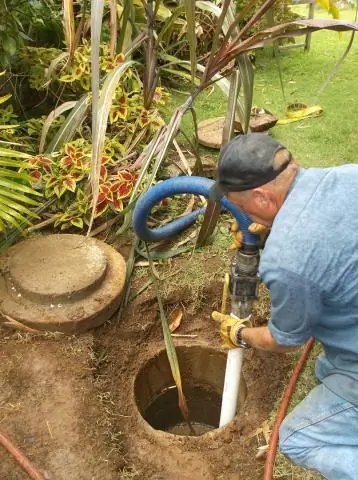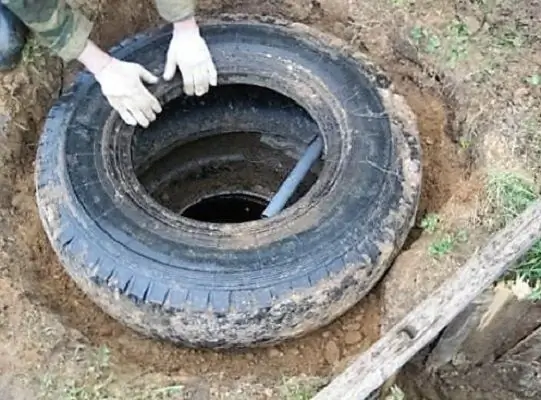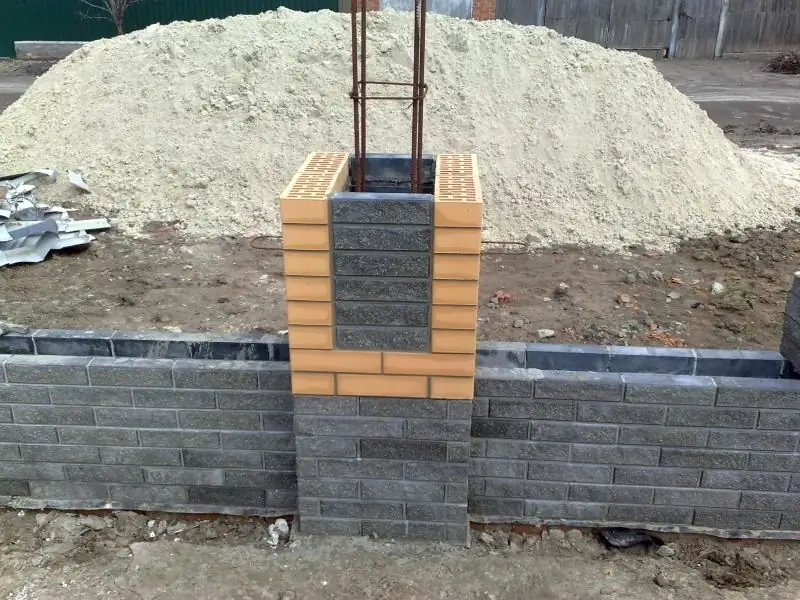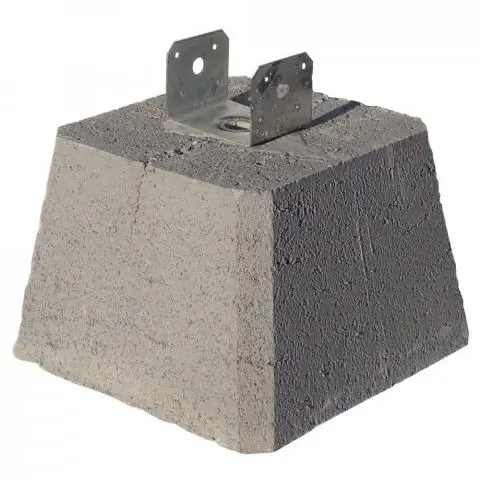
Table of contents:
- Cesspool and septic tank for a summer residence with your own hands
- Device, advantages and disadvantages of cesspools
- The device and features of septic tanks without pumping
- Pros and cons of pumping
- A cesspool from a barrel that does not require pumping out wastewater
- How to build a septic tank in the country
- Recommendations for the operation of the cesspool and septic tank
- Author Bailey Albertson [email protected].
- Public 2024-01-17 22:26.
- Last modified 2025-06-01 07:32.
Cesspool and septic tank for a summer residence with your own hands

It is possible to call living in a country house or in a country house convenient and comfortable only if there is a properly equipped sewage system on the site. The modern building materials market makes it possible to install a waste tank of any design, providing a choice of several options for solving the problem. Of course, factory sewer storage tanks and kits for their manufacture will require additional financial investments, but an inexpensive, workable system can be made with your own hands. For this, various materials are suitable, including those remaining after the construction of the house. The decision to tackle the issue on its own will bring another bonus - by choosing the design of a septic tank or a cesspool without pumping out drains, you can also save money during the operation of the structure. Let's take a closer look at the process of building two simple ones,but reliable and efficient structures.
Content
- 1 Device, advantages and disadvantages of cesspools
- 2 The device and features of septic tanks without pumping
- 3 Pros and cons of pumping
-
4 Cesspool from a barrel that does not require pumping out wastewater
- 4.1 Preparatory activities
- 4.2 Tools and materials
- 4.3 Instructions for making a cesspool from a barrel with your own hands
- 4.4 Video: cesspool from a barrel at a summer cottage
-
5 How to build a septic tank in the country
- 5.1 Design and calculation
- 5.2 Photo gallery: drawings of the future structure
- 5.3 Tools and materials
- 5.4 How to make a septic tank from concrete rings
- 6 Recommendations for the operation of a cesspool and septic tank
Device, advantages and disadvantages of cesspools

The cost of plant treatment facilities is still quite high. A good alternative to such structures are homemade septic tanks and cesspools.
A cesspool is the simplest way of arranging a local sewage system, due to which this type of waste storage is most common in suburban areas. It is quite easy to make a waste tank of this type. To do this, at a depth below the level of freezing of the soil, a container is installed or built, to which a sewer line is drawn from all drain points located in the house. After filling the pit with sewage, they are pumped out and removed from the site using sewage trucks. For this, a hatch is provided by the design of the reservoir, which is also used to monitor the level of wastewater.
Depending on the design, all cesspools are divided into two types:
- storage facilities without a bottom;
- sealed waste containers.
The first are of the filtration type. Once in the cesspool, wastewater is absorbed into the soil and, with the help of microorganisms, is processed into water and the simplest organic compounds. The coarse fraction settles at the bottom of the storage tank, where it is also exposed to bacteria, turning into sludge and liquid. In order for the decomposition process to take place more actively, special agents with biologically active components are added to the drains. Due to the absorbing capacity of the soil and the processing of sewage by bacteria, the volume of wastewater in the storage tank is greatly reduced. The remaining sediments are rarely pumped out, therefore, structures of this type are otherwise called cesspools without pumping.

Sump design without pumping out
Sewer tanks of the second type are sealed systems, therefore, they require regular use of the services of sewage trucks. Nevertheless, such cesspools are the safest in terms of impact on the environment and in some cases represent the only possible option for arranging the sewerage system of a country house or summer cottage.

When constructing a sealed cesspool, one must be ready for the regular use of sewage trucks
Advantages of cesspools without pumping out:
- simple design allows you to build a storage tank with your own hands;
- the possibility of using various materials for construction;
- increased interval between wastewater pumping;
- low cost and low operating costs.
It would seem that the design of filtration cesspools should not have alternatives, right? In fact, this option has significant disadvantages, which can sometimes cancel out all the advantages:
- high requirements for the choice of installation site;
- decrease in absorptive capacity over time;
- the possibility of unpleasant odors on the site;
- environmental hazard;
- the use of special bacterial compounds makes it impossible to use chemical detergents.
The device and features of septic tanks without pumping
By spending a little money, you can build a more perfect drainage system - a septic tank. It differs from a simple waste pit in the presence of several tanks designed for the processing of sewage by anaerobic bacteria. During the decomposition of organic waste, they are converted into a homogeneous mass and the fetid odor is neutralized. In modern systems, the possibilities of biological processing and gravity sedimentation are complemented by compulsory post-treatment methods. The use of biofuel and biofilters allows you to filter up to 95% of wastewater. Unlike a cesspool, septic tanks undergo an anaerobic process, due to which all bottom sediment is processed into sludge and liquid.

The presence of several chambers allows the use of an anaerobic method of purifying wastewater with their subsequent discharge into a filtration well
Just like a cesspool, a septic tank can be built with your own hands. Of course, it has a more complex design, but no expensive materials are required to manufacture it.
Having decided to install a septic tank on your site, you get a lot of advantages:
- lack of unpleasant odor due to the sealed design;
- you can completely do without the services of a sewer, using the sludge residue as fertilizer for the garden;
- the risk of groundwater contamination by sewage drains is greatly reduced;
- the multi-stage cleaning system works effectively for a long time, providing a constant sewage throughput;
- a septic tank is a structure that practically does not change the ecological balance of the area.
The disadvantages of this type of treatment plant include:
- complicated design, involving the installation of several chambers, overflow and filtration systems;
- the need for complete tightness of the structure;
- higher construction cost compared to a cesspool.
As you can see, the disadvantages of a septic tank are few in number and are associated with the complication of the design, which ultimately leads to an increase in the cost of construction. As for operating costs, they are considered insignificant.
Pros and cons of pumping
The existence of two parallel structures of cesspools and septic tanks, one of which is a storage type system, and the other is a filtration system, gives rise to many disputes over the cost of operation and efficiency of use. To eliminate any speculation and rumors, we will try to give a comparative analysis of the positive and negative aspects associated with the regular removal of wastewater from the site.
Advantages of sewer tanks with wastewater pumping:
- softer requirements for choosing a place for installing wastewater facilities;
- high environmental friendliness of structures allows you to comply with all norms of environmental and sanitary legislation;
- long service life without the need to transfer the sewage reservoir to a new location;
- lack of unpleasant odors associated with the disposal of processed wastewater into the ground;
- there is no need to use special preparations required for biological processing and filtration;
- the ability to use any type of household chemicals.

One of the disadvantages of pits without pumping is that not all materials at hand can be used in their manufacture.
Cons of systems with pumping:
- the complication of the design of waste containers associated with the drainage of liquid into the ground;
- it is necessary to ensure the tightness of the structure during operation;
- the inability to use chemical detergents in everyday life;
- the need for bioloading;
- increasing the cost of construction;
- higher requirements for building materials.
When deciding on the installation of one or another sewage system, first of all, one must proceed from the requirements of environmental and sanitary legislation. The opportunity to save money is not always justified, especially when it comes to the health of others.
A cesspool from a barrel that does not require pumping out wastewater

For the manufacture of a cesspool without pumping out, an ordinary plastic barrel is suitable
With a small volume of wastewater or irregular use of the sewage system, a plastic or metal barrel is an excellent option for a storage tank. When choosing a tank for connecting to a toilet, you should give preference to a product as large as possible, since sooner or later you will have to remove the accumulation of non-degradable residues. Of course, in a humid, aggressive environment, a plastic tank will be more resistant, which does not lend itself to rotting or corrosion. Nevertheless, you can get by with a simple 200-liter metal barrel, for example, from under fuel and lubricants.
Preparatory activities
At the initial stage, it is necessary to determine the daily amount of wastewater. It should be understood that for a large volume of liquid household waste, you will need a tank containing several cubic meters of wastewater, equipped with an opening for sludge removal. If it is required to drain the kitchen sink, washbasin or washing machine installed in the country, then a small capacity will be enough.
Further, they choose a place for installing a sewer storage tank, which will meet all the requirements of regulatory organizations and ensure the safe operation of the sewer system. In addition, it is necessary to make a small drawing indicating the depth of the pit, the points of entry into the capacity of the waste pipelines, and the design features of the filtration layer.
Tools and materials
For the manufacture of a waste storage tank without pumping out, it is necessary to prepare the following materials and tools:
- metal or plastic barrel;
- angle grinder (grinder);
- electric drill and drill set;
- shovel;
- coupling and branch pipe for tapping the sewer pipe into the tank;
- plumbing sealant;
- roll geotextile (non-woven fabric);
- fine crushed stone and gravel.
Remember that a small sewer tank is more prone to freezing in winter than a sewage system designed for a few cubic meters of wastewater. This, as well as the fact that recycling occurs due to the absorption of liquid into the ground, makes it necessary to strictly comply with the installation conditions in terms of deepening the structure below the level to which the ground freezes.
Instructions for making a cesspool from a barrel with your own hands

Installation diagram of a cesspool from a barrel. The drainage layer ensures the absorption of wastewater into the ground
A drainage system without the need for pumping, made from a conventional barrel, is a special case of a drainage well. To install the container, you will need a small pit that can be dug out in a few hours. Its width is chosen based on the need for a 20 cm gap between the walls of the pit and the barrel, and the depth should ensure that the tank is installed below the freezing point of the soil, taking into account the thickness of the lower drainage layer (this parameter is taken equal to 50 cm or more). For example, if the frost gets to a depth of 1.5 m, and the height of the barrel is 1.2 m, then the depth of the pit should be at least 3.2 m (1.5 m + 1.2 m + 0.5 m).
When choosing a place for future construction, they follow the rules and regulations for the installation of filtration wastewater structures, trying to maintain a minimum distance from the discharge point. The phased implementation of work will make it possible not to miss a single detail and avoid installation errors.
-
Drainage holes are made in the barrel. If you are using a plastic container, they should be staggered at a distance of 15-20 cm from each other.
-

Drainage holes - How to make the correct drainage holes
-

Drainage holes - Too dense network of drainage holes can reduce the strength of the tank, therefore this is not recommended
As a rule, drilling with a diameter of 12 - 15 mm is sufficient for normal operation of the structure. In this case, the drainage network should cover not only the walls, but also the bottom of the tank. In a metal barrel, the bottom can be removed, and instead of a drill, use a grinder, cutting grooves up to 10 cm long in the same way.

barrel pit A common mistake is too large holes
-
-
A branch pipe is mounted on the lid of the barrel for connecting the sewage system. Its diameter should correspond to the size of the pipes that are used for the drain line. The junction points are treated with silicone sealant, which is applied both from the inside and outside of the structure.

Installation of the branch pipe Installation of a branch pipe for connecting a waste pipe
- To ensure that the drainage holes are protected from soil particles, the barrel is wrapped in non-woven geotextile. This material perfectly permeates water and is able to perform protective, filtering and drainage functions for a long time.
- Secure the geotextile using synthetic cord or duct tape. In this case, the inlet pipe is left open.
-
A 50-cm layer of crushed stone is poured at the bottom of the pit, and for a thin-walled plastic container, 5-10 cm of gravel or screenings are added over the drainage.

Tank installation Installation of the reservoir in the pit. It should be noted that drainage holes unprotected with geotextiles quickly become clogged.
- The tank is installed by orienting its outlet towards the sewer line.
-
Using a coupling, connect the drain pipe to the barrel.

Installation of a cesspool The connection of the sewer manifold can be done not only through the top, but also from the side. In this case, the cover can be used as a hatch for pumping out the bottom sediment.
- The space between the reservoir and the walls of the pit is filled with rubble and the structure is covered with soil.
In a similar way, you can build a drain pit connected to a toilet installed in the country. The only thing that is needed in this case is to cut a vertical pipe into the lid of the barrel that goes to the surface. This is necessary for the periodic pumping of non-degradable waste.
Video: cesspool from a barrel at a summer cottage
How to build a septic tank in the country
No matter how large a sump, its filtration and absorption capacity decreases over time due to particles of grease and dirt that clog the drainage pores. You can avoid these drawbacks and practically avoid pumping by installing a septic tank in the country. A simple, and most importantly, durable and effective structure can be built from concrete rings, which are quite affordable.
Design and calculation

Schematic representation of a three-chamber septic tank
When starting construction, the volume of the structure's sedimentation tanks is determined. To determine this parameter, you need to know the amount of wastewater that is generated in the country per day. It is not required to accurately measure this value, it is enough to take a flow rate of 150 liters per family member and add the water consumption of each unit of household appliances connected to the sewage system.
The volume of the receiving tank should contain three times the volume of the daily sewage discharge. A family of four will require a primary chamber with a volume of about 2.5 cubic meters. meters, that is, almost three standard concrete rings with a height of 890 mm and a diameter of 1 m. When building a septic tank, you can use ready-made drawings and diagrams. If they do not suit you in some way, when drawing up your project, do not forget about the correct ratio of the size of the structure and the need to ensure the complete tightness of the receiving chamber.
Photo gallery: drawings of the future design
-

Septic tank made of concrete rings - Scheme of a septic tank made of concrete rings
-

Septic tank made of concrete rings - Drawing of a septic tank made of concrete rings
-

Septic tank made of concrete rings - Drawing of a septic tank made of concrete rings
-

Septic tank made of concrete rings - Drawing of a septic tank made of concrete rings
-

Septic tank made of concrete rings - Drawing of a septic tank made of concrete rings
Tools and materials
To make a 3-chamber septic tank you will need:
- concrete rings - 9 pcs.;
- covers with hatches - 3 sets;
- pieces of sewer pipes with a diameter of 110 mm;
- cement;
- crushed stone;
- sand;
- reinforcement or steel bar;
- waterproofing;
- shovels and buckets;
- container for solution preparation;
- puncher.
How to make a septic tank from concrete rings
-
Using the services of an excavator or asking friends or relatives for help, you need to dig a pit. Its size should ensure the possibility of applying waterproofing to the outer walls of the structure.

Preparation of the pit Preparation of the pit for the installation of concrete rings
- The bottom of the pit is leveled and compacted, after which a cushion is constructed. For this, a 30-centimeter layer of sand is poured and thoroughly tamped, after which it is additionally poured with water.
-
At a distance of at least 5-7 cm from the bottom of the pit, an armored belt is installed, after which a concrete base is poured for two chambers.
If there is an opportunity to purchase rings made with a bottom, use it. This will shorten the construction time and ensure good sealing of the bottom.

Ring septic tank Installation of concrete tanks
- After the concrete has set, the rings of the first two chambers are installed using a crane or a winch. To increase the tightness of the structure, a layer of cement-sand mortar is applied to the upper cut of the lower ring, and the rings themselves, after installation, are additionally fixed with metal plates. This will avoid displacement or destruction of the elements of the septic tank during ground movements.
-
The third chamber is a filtration well, so perforated rings are used for it. In addition, a drainage cushion is equipped under the last tank, for which the bottom is covered with a layer of rubble at least 50 cm thick.

Ring assembly Installation of perforated rings of a filtration well
-
After the installation of all the chambers, an overflow system is mounted, for which a perforator makes holes in the side walls of the tanks. The pipe that connects the first and second chambers is installed 20 cm below the entry point of the sewer main. The place of entry of the overflow into the third container should be another 20 cm lower.

Septic tank installation Installation of the overflow system
-
Tank covers are mounted on the upper rings.

Installing covers Installation of concrete tank floors
-
All joints of the rings and places of passage of pipes are carefully sealed with cement mortar, and after it dries, bitumen mastic is additionally applied. The processing of the junction points is carried out both inside the septic tank and outside, ensuring the complete tightness of the structure. There is no need to seal the joints in the last chamber, since its function is to divert the treated wastewater into the ground.

Septic tank waterproofing The key to the correct operation of the septic tank is reliable waterproofing of containers.
- Hatches are installed on the covers of the tanks, after which the septic tank is covered with soil.
With a large number of drains, the septic tank is connected to the filtration fields. They are a system of perforated pipes installed at a slope in a sand-gravel layer. Moving by gravity from the last chamber of the septic tank, the water undergoes additional purification. The main thing is that the distance from the filtration fields to groundwater should be at least 2 m, otherwise the requirements of environmental and sanitary legislation will be violated.
Recommendations for the operation of the cesspool and septic tank
The use of biological products allows many times to increase the efficiency of the septic tank and reduce the contamination of the cesspool with fat deposits. The bacteria they contain actively process wastewater into water and a small amount of bottom sediment. Microorganisms destroy sewage so efficiently that they can even be used to restore the drainage properties of cesspools. The only drawback is that such products do not work well at temperatures below 4 ° C. In this case, you can use special chemicals.

Bioactivators and care products for septic tanks and cesspools
If a septic tank or cesspool has not been used for a long time, then the wastewater can be pumped out with a conventional drainage pump, using the liquid processed by bacteria as fertilizer for the garden or vegetable garden.
It should be remembered that a specially equipped sewage structure is not a waste container. Materials of inorganic origin, construction and household waste do not rot, therefore they will pollute the treatment structure, reducing its productivity. Use your drain as intended and it will pay you back with cost savings and reliable, long-term performance.
Having installed a cesspool or septic tank in the country, they get comfort and convenience comparable to living conditions in a comfortable city apartment. Due to the simple design, treatment facilities of this type are available for DIY installation, which avoids large financial costs during construction and during operation. However, it is not worth saving if the installation of sewage collectors carries a risk of environmental pollution.
Recommended:
How To Install Fence Posts With Your Own Hands, Including Without Concreting, At The Correct Distance And Depth - Instructions With Photos And Videos

How to install fence posts: installation methods, use of suitable materials
How To Choose And Build A Foundation For A Bath With Your Own Hands - 4x6, 3x4 And Other Sizes, Tips, Instructions, Photos And Videos

How to make a foundation for a bath with your own hands. Types and features of foundations. The choice of materials and technology, installation rules and step-by-step instructions
How To Make A Slime At Home With Your Own Hands - Without Sodium Tetraborate And Glue, From Hand Cream, Shaving Foam And Other Ingredients, Recipes With Photos And Videos

Is it possible to make a slime at home. Types of slimes and recipes for their manufacture, depending on the desired properties. Toy care features
How To Make A Barn With Your Own Hands From Boards Without A Foundation - Instructions With Photos And Videos

A shed of boards without a foundation: advantages and disadvantages. Selection of materials and tools. Preparation for construction and step-by-step instructions for construction
How To Make A Birdhouse Out Of Wood With Your Own Hands: Options With Drawings And Diagrams + Photos And Videos

How to make a wooden birdhouse with your own hands. The right tree, the necessary materials and tools, drawings, step-by-step manufacturing instructions. Video
